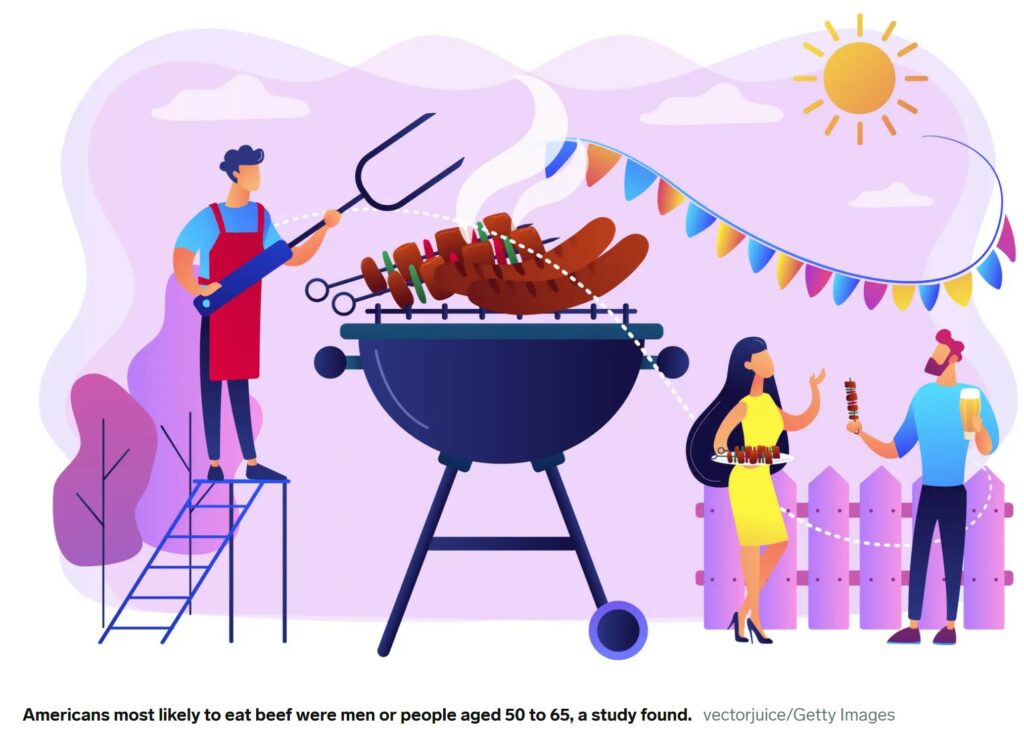12% of Americans are eating half of the nation’s beef
Men and Older Americans Eat the Most Beef, businessinsider.com, Catherine Boudreau
Just 12% of Americans are eating half of the nation’s beef — the ‘Hummer of animal proteins.’
- A study found twelve percent of Americans are eating half of all the beef consumed in the US in a day.
- Fifty- to sixty-five-year-old men are most likely to eat beef.
- Some benefits could be had for the planet if some people ditched beef for another protein.
Americans savoring the last bits of summer on Labor Day weekend might have been barbecuing, picnicking, or trying a new restaurant.
If so, there is a good chance beef is on the menu, especially for men or people ages 50 to 65. On average, teenage boys also consume more meat, poultry, and eggs than is recommended in the Dietary Guidelines for Americans.
These two groups were more likely to eat a disproportionate amount of beef in a day, according to a study published in the peer-reviewed journal “Nutrients.” About 12% of Americans reported that kind of diet and account for half the nation’s beef consumption that day.
The study was partially funded by the environmental advocacy group Center for Biological Diversity. It helped target educational and marketing campaigns encouraging more climate-friendly diets. Coauthor of the study and professor and nutrition program director, Diego Rose of Tulane University School of Public Health and Tropical Medicine, revealed this fact to Insider.
The food and agriculture industry accounts for a third of all greenhouse gas emissions globally which is driven in part by cattle burping methane and requiring vast swaths of land in which to graze. Beef produces an estimated 8 to 10 times more emissions than chicken, and 50 times more than beans. Diego Rose . . . (there is controversy on how much pollution [methane] results from cattle burping)
“Beef is an environmentally extravagant protein. It’s kind of like the Hummer of animal proteins.”
He added, he did not expect such a small percentage of Americans to account for an outsized amount of beef consumption.
“This was a big surprise to us.”
A “disproportionate” amount of beef was defined as four or more ounces a day or similar to a McDonald’s Quarter Pounder before it’s cooked. US Agriculture Department guidelines suggest eating four ounces per day of meat, poultry, and eggs combined for those eating 2,200 calories in a day.
Researchers also analyzed data from a federal nutrition survey asking more than 10,000 adults to report what they ate during the previous 24-hour period. Rose acknowledged a limitation of the study, because what people ate in one day might not be typical of their regular diets.
Still, the findings suggest there could be big benefits for the planet even if only a small number of people swap out beef for another protein. After all, the US is the second-largest beef consumer per-capita in the world behind Argentina.
Some people will be resistant to change, Rose said. Also noting beef is often entangled with the culture wars and the American identity. But others might not realize how much they’re eating and be open to substituting another protein with a lower carbon footprint for beef.
Nutrients | Free Full-Text | Demographic and Socioeconomic Correlates of Disproportionate Beef Consumption among US Adults in an Age of Global Warming, mdpi.com, Amelia Willits-Smith, Harmonii Odinga, Keelia O’Malley, Donald Rose



If you like to eat beef, and don’t care for the vegetarian substitutes, I urge you to consider bison instead. Bison are less damaging to the environment.
So what percentage of Americans who eat beef is this? Not sure this is that unique really if people who eat no beef are in the statistic population. Three percent of Americans eat half the lobster! A quarter percent of Americans eat 90% of the caviar!
What percentage of emissions does beef contribute? Is reducing beef consumption going to make that big a difference compared to a comparable reduction in transportation or utilities?
If personal health concerns don’t move beef consumption, do climate change concerns have a chance?
If we just stuck to recommended portion sizes (or double the recommended portion size) there would be a large reduction in the number of cattle needed to provide everyone who wants beef.
@Jane,
Google is your friend.
Livestock production—primarily cows—produce 14.5 percent of global greenhouse gas emissions. The majority of that is in the form of methane, a potent greenhouse gas that is a natural byproduct of how some livestock process food.”
https://www.pbs.org/newshour/show/cow-burps-are-a-major-contributor-to-climate-change-can-scientists-change-that#:~:text=Globally%2C%20cows%20and%20other%20livestock,of%20food%20on%20the%20planet.
@Jane,
Also too:
“Worldwide, deforestation due to cattle ranching releases 340 million tons of carbon into the atmosphere each year, or 3.4 percent of global greenhouse gas emissions. Most of this comes from the Amazon region.”
https://www.greenpeace.org/usa/forests/issues/agribusiness/#:~:text=Worldwide%2C%20deforestation%20due%20to%20cattle,comes%20from%20the%20Amazon%20region.
So is the 50-65 years-old age range a beef-eating sweet spot, or just more reflective of birth year? I don’t remember my cohort increasing beef consumption after 50, but can imagine those 15 or 20 years younger always eating less beef. I can imagine those older than 65 eating less beef along with less of most everything else, too. Maybe just waiting will shift the pattern considerably.